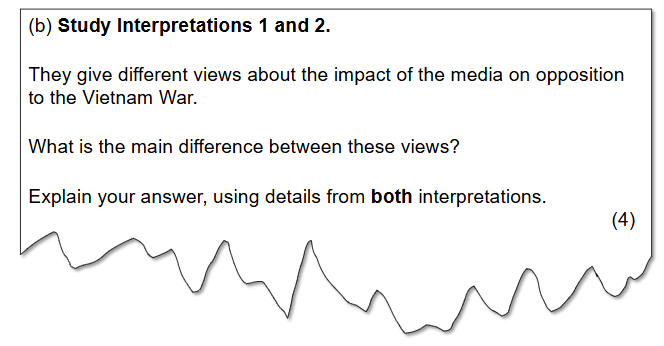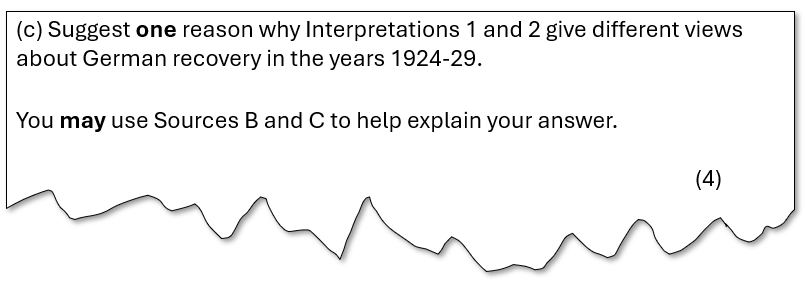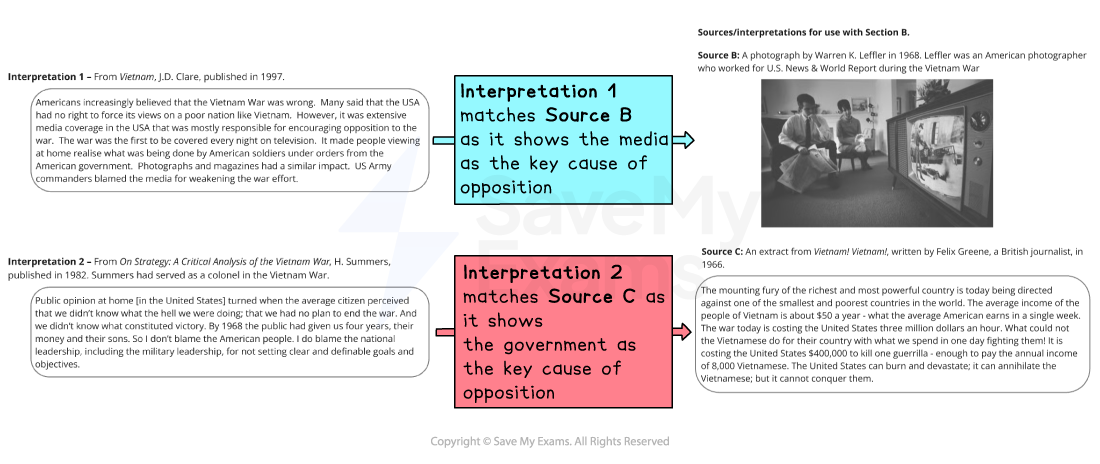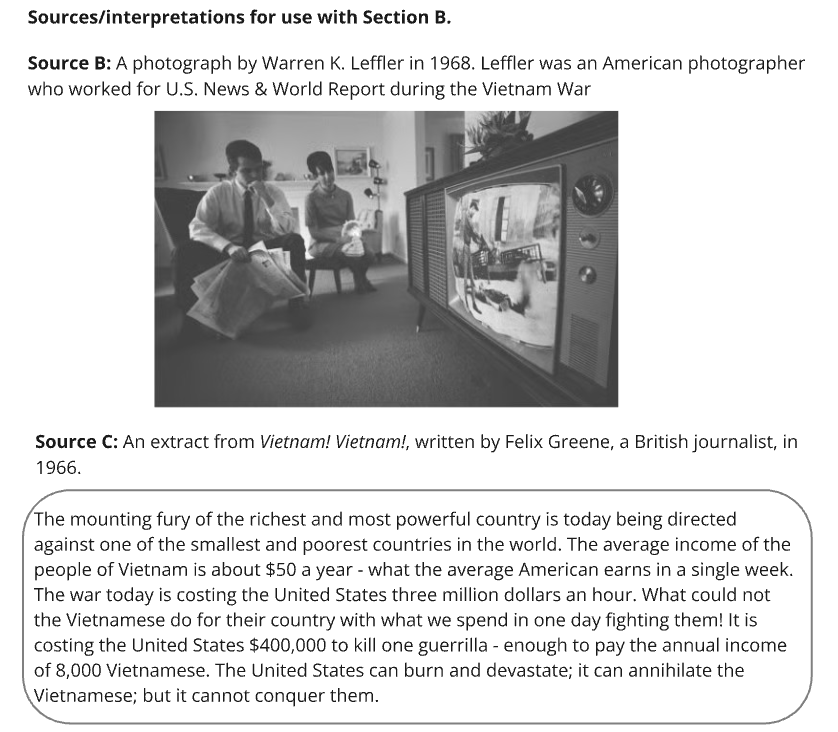Comparing Interpretations Questions (Edexcel GCSE History): Revision Note
Exam code: 1HI0
Summary of Question 3 (b)
Question 3 (b) asks you to explain the difference between Interpretation 1 and Interpretation 2
The interpretations used in Question 3 (b) will be the same interpretations used in Questions 3 (c) and (d)
Amount of marks | 4 |
|---|---|
The time that you should spend on the question | No more than 5 minutes |
An example of the type of question you may encounter can be seen below:

In previous years, this question has focused on the following topics in The USA, 1954–75:
Year of Exam
Question Topic
2018
The Tet Offensive on American attempts to win the Vietnam War (opens in a new tab)
2019
The achievements of the civil rights movement, 1960–65 (opens in a new tab)
2020
Reasons for the failure of the USA in Vietnam (opens in a new tab)
2021
The position of Black Americans in the 1950s (opens in a new tab)
2022
The methods used by the Black Panther movement (opens in a new tab)
2023
The Freedom Summer (1964) (opens in a new tab)
2024
The achievements of Martin Luther King in the civil rights movement
What is an interpretation question?
An interpretation is someone's point of view about a historical event, person or time period
Interpretations focus on different ideas or evidence, so they may not always agree
These interpretations could be written:
After the event
By people who were there at the time
By historians
You will be given two interpretations from the Sources/ Interpretations Booklet
This is a separate booklet from your answer paper
It includes the key interpretations you'll need for Section B
![Interpretation 1 is from Vietnam, J.D. Clare, published in 1997:
"Americans increasingly believed that the Vietnam War was wrong. Many said that the USA had no right to force its views on a poor nation like Vietnam. However, it was extensive media coverage in the USA that was mostly responsible for encouraging opposition to the war. The war was the first to be covered every night on television. It made people viewing at home realise what was being done by American soldiers under orders from the American government. Photographs and magazines had a similar impact. US Army commanders blamed the media for weakening the war effort."
Interpretation 2 is from On Strategy: A Critical Analysis of the Vietnam War, H. Summers, published in 1982. Summers had served as a colonel in the Vietnam War:
"Public opinion at home [in the United States] turned when the average citizen perceived that we didn't know what the hell we were doing; that we had no plan to end the war. And we didn't know what constituted victory. By 1968, the public had given us four years, their money and their sons. So I don't blame the American people. I do blame the national leadership, including the military leadership, for not setting clear and definable goals and objectives."](https://cdn.savemyexams.com/cdn-cgi/image/f=auto,width=3840/https://cdn.savemyexams.com/uploads/2025/08/48122_httpscdn-savemyexams-comuploads20250821264-httpscdn-savemyexams-comuploads20250854090-httpscdn-savemyexams-comuploads20250858850-httpscdn-savemyexams-comuploads20250744033-interpretations-usa.png)
Question 3 (b) — "What is the main difference?"
The two interpretations used in Question 3 (b) will always be different from one another
In Edexcel The USA, 1954–75: Conflict at Home and Abroad, interpretations are different based on the following themes:
Political developments (e.g. Civil Rights Act or presidential actions in Vietnam)
Social and cultural developments (e.g. opposition to civil rights and the Vietnam War)
Economic developments (e.g. the economic effects of the Vietnam War)
"What is the main difference?" question structure
Your answer needs to:
Identify and explain the main difference in content between Interpretation 1 and Interpretation 2 (In)
Support your explanation with a short quote or clear summary from each interpretation (In)
To achieve full marks, you need to include both Interpretation 1 and Interpretation 2 in your answer
Worked example of a "What is the main difference?" question
Worked Example
3 (b) Study Interpretations 1 and 2. They give different views about the impact of the media on opposition to the Vietnam War.
What is the main difference between these views?
Explain your answer, using details from both interpretations.
(4)
![Interpretation 1 – From Vietnam, J.D. Clare, published in 1997.
"Americans increasingly believed that the Vietnam War was wrong. Many said that the USA had no right to force its views on a poor nation like Vietnam. However, it was extensive media coverage in the USA that was mostly responsible for encouraging opposition to the war. The war was the first to be covered every night on television. It made people viewing at home realise what was being done by American soldiers under orders from the American government. Photographs and magazines had a similar impact. US Army commanders blamed the media for weakening the war effort."
Interpretation 2 – From On Strategy: A Critical Analysis of the Vietnam War, H. Summers, published in 1982. Summers had served as a colonel in the Vietnam War.
"Public opinion at home [in the United States] turned when the average citizen perceived that we didn’t know what the hell we were doing; that we had no plan to end the war. And we didn’t know what constituted victory. By 1968, the public had given us four years, their money and their sons. So I don’t blame the American people. I do blame the national leadership, including the military leadership, for not setting clear and definable goals and objectives."](https://cdn.savemyexams.com/cdn-cgi/image/f=auto,width=3840/https://cdn.savemyexams.com/uploads/2025/08/20639_httpscdn-savemyexams-comuploads20250836600-httpscdn-savemyexams-comuploads20250860287-httpscdn-savemyexams-comuploads20250816930-httpscdn-savemyexams-comuploads2025084510-httpscdn-savemyexams-comuploads20250840309-httpscdn-savemyexams-comuploads20250850525-httpscdn-savemyexams-comuploads20250722102-interpretations-usa.png)
Answer:
Interpretations 1 and 2 give different views about why public opinion in the USA turned against the Vietnam War (In). Interpretation 1 argues that media coverage was the main reason for growing opposition. It says that the war being shown "every night on television" made people realise "what was being done by American soldiers under orders from the American government" (In). In comparison, Interpretation 2 focuses on failures in US leadership and strategy as the cause of opposition (In). It claims that citizens realised "we didn't know what the hell we were doing" and that "we had no plan to end the war" (In).
Summary of Question 3 (c)
Question 3 (c) asks you to explain why the interpretations are different
You should not repeat what you have written in Question 3 (b)
The interpretations used in Question 3 (c) will be the same interpretations used in Questions 3 (b) and (d)
You can use Sources B and C in this question
However, if you choose not to use them, you can receive full marks
Amount of marks | 4 |
|---|---|
The time that you should spend on the question | No more than 5 minutes |
An example of the type of question you may encounter can be seen below:

In previous years, this question has focused on the following topics in The USA, 1954–75:
Year of Exam
Question Topic
2018
The Tet Offensive on American attempts to win the Vietnam War (opens in a new tab)
2019
The achievements of the civil rights movement, 1960–65 (opens in a new tab)
2020
Reasons for the failure of the USA in Vietnam (opens in a new tab)
2021
The position of Black Americans in the 1950s (opens in a new tab)
2022
The methods used by the Black Panther movement (opens in a new tab)
2023
The Freedom Summer (1964) (opens in a new tab)
2024
The achievements of Martin Luther King in the civil rights movement
Question 3 (c) — "Why are interpretations different?"
Interpretation 1 and Interpretation 2 may have different interpretations due to:
The types of sources they have used
For example, some interpretations may have placed more weight on political sources, whereas others may use more economic sources
The authors' focus on short-, medium- or long-term developments or effects
For example, some interpretations may have focused on the short-term effects of an event such as the Greensboro sit-ins
Others may focus on the long-term effects
Do not refer to provenance
You will not receive any marks for an explanation focused on the provenance
"Why are the interpretations different?" question structure
The most common way of structuring this answer is by using Sources B and C
One of the sources will support the argument made in Interpretation 1
The remaining source will agree with the argument given in Interpretation 2
Do not use Source A in your answer, as you will not receive any marks

Using this method, you would use the following structure in your answer:
State that the historians' viewpoints differ because they have given weight to different sources (In)
For Interpretation 1, state that they have looked at sources such as Interpretation 1's matching source (either Source B or C)
Use quotes or details from the source and from Interpretation 1 to show how they connect (In)
Repeat this structure for Interpretation 2, using its matching source
Do not use irrelevant information from the interpretations that are not based on the question
Worked example of a "Why are the interpretations different?" question
Worked Example
3 (c) Suggest one reason why Interpretations 1 and 2 give different views about the impact of the media on opposition to the Vietnam War.
You may use Sources B and C to help explain your answer.
(4)

![Interpretation 1 – From Vietnam, J.D. Clare, published in 1997.
"Americans increasingly believed that the Vietnam War was wrong. Many said that the USA had no right to force its views on a poor nation like Vietnam. However, it was extensive media coverage in the USA that was mostly responsible for encouraging opposition to the war. The war was the first to be covered every night on television. It made people viewing at home realise what was being done by American soldiers under orders from the American government. Photographs and magazines had a similar impact. US Army commanders blamed the media for weakening the war effort."
Interpretation 2 – From On Strategy: A Critical Analysis of the Vietnam War, H. Summers, published in 1982. Summers had served as a colonel in the Vietnam War.
"Public opinion at home [in the United States] turned when the average citizen perceived that we didn’t know what the hell we were doing; that we had no plan to end the war. And we didn’t know what constituted victory. By 1968 the public had given us four years, their money and their sons. So I don’t blame the American people. I do blame the national leadership, including the military leadership, for not setting clear and definable goals and objectives."](https://cdn.savemyexams.com/cdn-cgi/image/f=auto,width=3840/https://cdn.savemyexams.com/uploads/2025/08/45309_httpscdn-savemyexams-comuploads20250845236-httpscdn-savemyexams-comuploads20250833356-httpscdn-savemyexams-comuploads20250811504-httpscdn-savemyexams-comuploads20250722102-interpretations-usa.png)
Answer:
Interpretations 1 and 2 give different views about the media's impact because they have given weight to different sources (In). Interpretation 1 may have been influenced by sources such as Source B. The image shows a family watching graphic war footage on their television, likely at home in the USA. This supports Interpretation 1's view that television made Americans "realise what was being done by American soldiers" and that media coverage "was mostly responsible for encouraging opposition" (In). However, Interpretation 2 will have studied sources such as Source C. In it, Greene criticises the USA's huge spending and failure to win, stating, "it is costing the United States $400,000 to kill one guerrilla". This supports Interpretation 2's argument that opposition came from the belief that "the public had given us four years, their money and their sons" (In).

Unlock more, it's free!
Did this page help you?